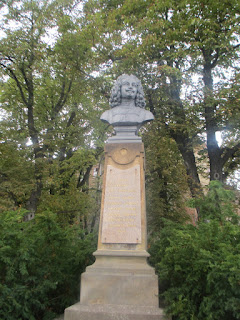---oOo---
The Czech Republic is a wonderful country if you are interested in exploring a large variety of castles. Due to the fact that the Czech Republic belonged to the Habsburg Empire until 1918, you can imagine the splendour and loveliness of these buildings, which can be experienced in a wonderfully old-fashioned and comfortable way by traveling through the country by train.
Brno, the second largest town in the Czech Republic and about 2 hours away from Vienna, is home to two historical buildings that very much shape the city’s silhouette. One of them is the Cathedral of St. Peter and Paul, towering majestically over the city on Petrov Hill, with the other being Špilberk Castle, situated on yet another hill and often acting as a stunning background for photos taken in the city centre of Brno!
While Špilberk Castle’s cream-coloured exterior might lack the Baroque embellishments so often admired in castles, it has to be remembered that during the Habsburg reign, it was first and foremost used to fight off enemies and house the most dangerous criminals within the monarchy! Even though it was originally created as a residence for King Ottokar II. of Bohemia in the 13th Century, Špilberk Castle was eventually turned into a fortress and a prison in the 16th Century. Therefore, the castle had to be solid and look as threatening as possible to those wishing to attack the city of Brno. Today, the castle’s exterior has been restored to the way it looked in the late 18th Century, and it does, indeed, feature a Baroque tower on one side of the building. This tower can be climbed for a small fee, and offers a breathtaking aerial view of Brno! Even climbing the stairs of the tower is quite the experience, and makes one feel as if one has traveled back in time to the heyday of Empress Maria Theresa of Austria.
 |
| Raduit de Souches |
As mentioned above, Špilberk Castle was used as a fortress, due to its strategically convenient position. In 1645, in the course of the Thirty Years’ War, it was heavily attacked during the Swedish siege. The man who successfully defended Brno and made Špilberk Castle ready for battle was Raduit de Souches, a French nobleman who fought for the Habsburgs. He is truly one of the heroes of the history of Brno, and is commemorated throughout the city. When climbing the castle hill, one can see and pose for pictures with a bust of the man himself. His grave can also be found in Brno, namely in the Church of St. James, in the very centre of Brno.
Špilberk Castle is quite famous for its casemates. Originally built to store weapons and house soldiers, they were eventually turned into a prison by Maria Theresa’s son Emperor Joseph II in 1783. It was intended for only the most brutal and violent criminals within the Habsburg territory. Throughout the vast lands of the Habsburg dynasty, all of its residents feared being put into Špilberk Castle, so one can’t help but wonder whether its mere existence actually helped to lower crime rates! The castle’s basement served as a last home to those imprisoned for life. No one ever escaped from that prison, even though some cheeky criminals obviously had to (falsely) claim that they did! Eventually, in 1855, Emperor Franz Joseph I. closed the prison for good.
The castle features various exhibitions on the history of Brno and Špilberk Castle, and it is also possible to visit the famous casemates. A wonderfully spooky experience! The exhibition on the history of Brno features various historical items, such as clothes, furniture, porcelain…it really is possible to get lost inside that castle for an entire day! Make sure to also visit the Baroque pharmacy, which is situated within the castle’s gift shop. It dates back to the 18th Century and used to belong to the Elizabethan Convent in Brno.
When making one’s way back to the city centre of Brno, it is incredibly idyllic, and, dare I say, even romantic, to descend the castle hill and take in all of its nature and incredible views of the city. History and nature are combined at its best here!
About the Author
All content of this post copyright © Julia Meister, 2017.


No comments:
Post a Comment